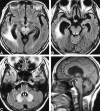Wernicke's encephalopathy: atypical manifestation at MR imaging
- PMID: 11559494
- PMCID: PMC7974565
Wernicke's encephalopathy: atypical manifestation at MR imaging
Abstract
We report a case of atypical manifestation of hyperintense lesions in a 64-year-old female patient with Wernicke's encephalopathy. Fluid-attenuated inversion recovery and T2-weighted images demonstrated symmetrical distribution of hyperintense lesions in cerebellar dentate nuclei, tegmentum of the lower pons, red nuclei, and tectum of the midbrain, and T1-weighted sagittal images showed atrophy of the mamillary bodies. The hyperintense lesions were completely resolved on follow-up MR images.
Figures



References
-
- Opdenakker G, Gelin G, De Surgeloose D, Palmers Y. Wernicke encephalopathy: MR findings in two patients. Eur Radiol 1999;9:1620-1624 - PubMed
-
- Yoon HK, Chang KH, Lee G, et al. MR findings of Wernicke encephalopathy. J Korean Radiol Soc 1991;27:485-491
-
- Suzuki S, Ichijo M, Fujii H, Matsuoka Y, Ogawa Y. Acute Wernicke's encephalopathy: comparison of magnetic resonance images and autopsy findings. Intern Med 1996;35:831-834 - PubMed
Publication types
MeSH terms
LinkOut - more resources
Full Text Sources
Medical
